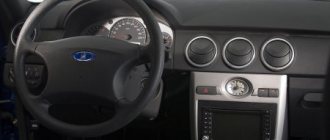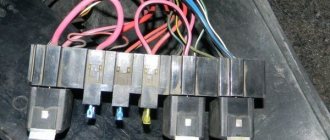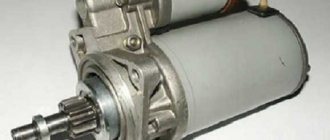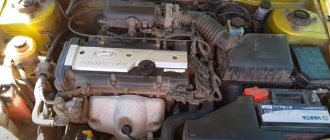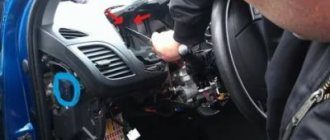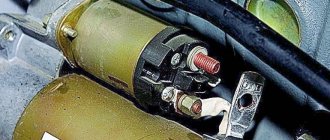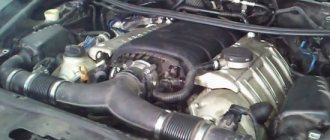The inability to operate the power unit when cold or after heating to a certain temperature can indicate a fairly large list of possible problems. The engine begins to stall suddenly and is unstable in different modes, after which the internal combustion engine stops.
In this article, we will talk about the reasons why an engine stalls when idling, why a hot engine stalls, why a car stalls on a moving hot engine, etc.
Read in this article
Idle speed regulator Lada Kalina and its device
- a housing in which a stepper motor is located with two windings independent of each other, rotor supports (rear and front);
- valve shut-off needle and spring;
- power connector.
3 main functions of the controller
1. In addition to maintaining the required engine speed, the device ensures its proper operation under cold start conditions (warming up at sub-zero air temperatures). In this case, the regulator provides higher engine speeds until the latter warms up to operating temperature. 2. The second important function that many drivers don’t even think about is the speed maintenance mode without pressing the gas pedal. In other words, ensuring the engine operates at idle speed is the merit of the IAC. 3. The third and very important purpose of the product is to ensure the creation of an air-fuel mixture of the required concentration and saturation. This feature has a positive effect on final fuel consumption and smooth engine operation.
Fuel filter
It doesn’t matter what the driver owns – a VAZ or a foreign car. All cars, without exception, stall “equally well” due to problems with the fuel filter. Most often, such a misfortune befalls really old models that have been in service for many years. The engine stalls due to interruptions in the fuel supply, which in turn begin due to filter contamination.
What to do: you need to remove the gasoline pump and replace the filter. Check the jar for blockages. If there is one, to prevent a quick recurrence of the breakdown, clean the fuel container.
Troubleshooting options
It is clear that if any emergency situations arise with the motor, it is advisable to contact a specialized service. However, this procedure is not always possible. Therefore, it is worth knowing how to independently diagnose the main systems and key parts.
Throttle valve and assembly
When the speed drops at idle and the car stalls, you need to pay close attention to the details of the throttle assembly. Long-term operation of the car on low-quality fuel and untimely maintenance of the air filter can lead to malfunctions of the throttle valve. It periodically jams if debris gets into the equipment.
Throttle valve VAZ 2112
The problem can be solved by cleaning the system. The throttle is cleaned using carburetor cleaners. Using a compressor, you need to blow out the damper under the pressure of compressed air. It is not recommended to touch the screws located inside and on the side. If cleaning does not correct the situation, the device must be replaced. This operation is not particularly difficult.
Crankcase malfunction
There is an oil trap in the crankcase ventilation system of the engine. Its contamination can also lead to interruptions in engine operation. Crankcase gases do not allow the engine to function normally, the speed fluctuates, the internal combustion engine stalls.
Sensors
If a gasoline car stalls at idle, then one of the sensors is likely to break. In injection cars with an electronic engine control system, the engine usually starts normally, but then it stops working. It's worth checking here:
- Electronic car indicators;
- DRХХ – device that regulates idle speed;
- Air flow meter (air intake in the carburetor);
- Sensor indicating the position of the throttle curtain.
Electronic control unit in VAZ 2114
Interruptions in the operation of any sensors immediately affect the behavior of the electronics - errors appear in the car control unit. The “brains” of the machine receive unreliable information. It is not transmitted correctly to the engine. It starts working with parameters that do not correspond to reality. Self-testing of this device is not possible. You need to contact a professional for service.
Diagnostics of mass air flow sensor
The idle air control device is usually to blame for engine malfunction when the car idles poorly. But you pressed the gas pedal and the engine started. In the latest VAZ modifications, error information appears on the instrument panel.
When diagnosing, you must use a multimeter. If a part is faulty, it is recommended to replace it with a new one. All sensors are reasonably priced. It is better to start checking with parts that have a simpler design. Then gradually move on to complex devices. We must not forget that the problem may lie not only in the sensors themselves. It is also necessary to check the wiring to them and the presence of stable contact.
Carburetor
If the VAZ carburetor stalls at idle speed, then the jets may become clogged. Low-quality gasoline, deposits from the gas tank, contain small particles of debris. They can easily disrupt the operation of the fuel injection system. It is worth replacing the filter in front of the carburetor and cleaning the device itself. The dispensing part is cleaned using a cleaning solvent, which is sold in aerosol cans. Another reason is often a prolonged lack of carburetor adjustment.
In a mechanical fuel pump of carburetor cars, the filter mesh may be clogged with dirt. This reduces the performance of the device. Wear of the membrane and its destruction often leads to clogged carburetor channels.
Injector
A situation that often arises is that various Lada models, as well as the VAZ 2110 injector stalls at idle. It is necessary to check the fuel pump strainer for clogging. This is a common problem with injection machines. It is better to immediately replace the part with a working one.
Filter problem
If the VAZ 2112 stalls at idle, then the fuel filter may be dirty. This also applies to other models of the concern. Generally, it is not practical to clean it. The part must be replaced. The same should be done with a dirty air filter. Low throughput leads to the fact that the air-fuel mixture simply floods the spark plugs.
Checking the operation of the throttle valve
Very often, the cause of idle “floating” is a malfunction of the throttle position sensor (TPS). The graphite track inside a standardly installed part wears out over time, so it is replaced with a sensor with a non-contact system. After replacement, you need to reset the sensor error. To do this, disconnect the terminals from the battery for 30 seconds or more.
It is also necessary to check the cleanliness and integrity of the pipe leading from the air filter to the throttle valve, and adjust the tension of the gas pedal cable going to it.
It is also possible that the gasket of the throttle assembly has become unusable or the assembly itself needs to be thoroughly cleaned (motor oil could have gotten into it) with special compounds for washing carburetors.
Call Putin))) 495 879586741)))) he is with us………
Yes, I’ve been everywhere... I mean websites) who writes much, of course, the main reasons are indicated by the timing belt, sensor, coil (which were changed, to no avail). The diagnostician will arrive tomorrow
Let's sum it up
Having completed the assembly process, we check the correct functioning of the valve-regulator on the LADA Kalina car. If the idle speed is within the specified limits, then the device is installed correctly, and no third-party air leaks are observed in the intake system.
The Lada Kalina idle speed sensor or IAC is a device that is responsible for the necessary air supply to the internal combustion engine when it is idling (in the absence of pressure on the gas pedal). For example, the driver releases the accelerator pedal and the air supply to the internal combustion engine stops. To prevent the engine from stalling, the idle speed sensor comes into operation, which is involved in the process of supplying the required amount of air bypassing the throttle assembly.
In other words, the IAC is a kind of valve-regulator. It is very important for every car owner to know and understand the principles of operation of the product, because if it breaks down, in most cases the car’s self-diagnosis system does not determine the reason for the incorrect operation of the engine.
Eliminating air leaks
Air leaks are another common cause of difficult engine starting. If you choke on air, or even stall, don’t even doubt it – it’s an air leak. You need to look for it in the following places:
- through the intake manifold gasket;
- vacuum booster;
- throttle valve gasket;
- adsorber valve;
Carefully check all these elements, as well as the condition of the seals. Go through all the air ducts, there may be damage somewhere. The vacuum system hoses must also be intact. You shouldn't forget about them. You can also use the following method: turn on the engine, let it run for a while, then walk around the car and listen in the hope of catching the sound characteristic of air leaking.
It will be sizzling. Next we clamp the hoses going to the intake manifold. After we have wrung out the hoses, we monitor the operation of the engine. If there are changes, it means there is leakage in the area of the vacuum booster and pressure regulator. In general, this problem is quite serious. requires a lot of time and perseverance. But he is quite capable of handling it himself.
Vikizzz
Participant
A problem that we cannot solve for a long time. Kalina, 1.4 engine with electronic throttle (Bosch ME17.9.7). In the morning when it's cold it starts hard. It starts up, and until it warms up to 50 degrees, when you press the gas, it starts to throttle and stalls. There is also a problem with the hot button, but not as much.
We changed the mass air flow sensor, DC valve, and fuel pump (pressure from 3.5 to 4). HBO is installed, but the problem disappears on gas! The engine responds adequately to the gas pedal! There is a suspicion about the injectors, but how can their operation be related to the temperature - more or less everything works when it’s hot. Anyone have any thoughts on this? Thank you in advance!
Participant
A problem that we cannot solve for a long time. Kalina, 1.4 engine with electronic throttle (Bosch ME17.9.7). In the morning when it's cold it starts hard. It starts up, and until it warms up to 50 degrees, when you press the gas, it starts to throttle and stalls. There is also a problem with the hot button, but not as much.
We changed the mass air flow sensor, DC valve, and fuel pump (pressure from 3.5 to 4). HBO is installed, but the problem disappears on gas! The engine responds adequately to the gas pedal! There is a suspicion about the injectors, but how can their operation be related to the temperature - more or less everything works when it’s hot. Anyone have any thoughts on this? Thank you in advance!
More than once, Lada Kalina car owners have encountered the concept of a car starting up and immediately stalling. There are few reasons for this phenomenon, but they can create discomfort, and the car may simply not start at the most necessary moment.
Video with a solution to the “double start” problem on the Lada Kalina (starts and immediately stalls):
Lada Kalina 2006 stalled while driving.
October 21, 2022, 16:54 #1
It stalled while driving, all the indicators work, the pump does not pump, the starter does not spin, all fuses are normal, what could it be?
October 21, 2022, 16:54 #2
21 October 2022, 17:15 #3
kosin, October 21, 2022, 16:54, #1
It stalled while driving, all the indicators work, the pump does not pump, the starter does not spin, all fuses are normal, what could it be?
Are you sure everything is normal? Have you looked under the center console? There are relays and fuses, which, by the way, are responsible for exactly what you described.
21 October 2022, 17:17 #4
Have you checked these? and even further, right under the center console, the relays are located
1 diagnostic connector
2 Main relay circuits (winding of the cooling system electric fan relay, canister purge valve, air flow sensor, speed sensor, oxygen concentration sensor, ignition coil)
3 Fuel pump
4 Electronic control unit (constant power circuits)
21 October 2022, 17:22 #5
Also check the positive wire at the starter.
21 October 2022, 17:24 #6
October 21, 2022, 6:10 pm #7
Well, if only the relays, where they are located I only know how to check their ability to work?
October 21, 2022, 6:14 pm #8
The most interesting thing is that all this happened on the fly!
21 October 2022, 18:32 #9
kosin, October 21, 2022, 18:14, #8
The most interesting thing is that all this happened on the fly!
If you're driving, check the negative on the engine, there have been cases where when it comes loose, it does bad things, including failure of the ECM
21 October 2022, 19:57 #10
A friend had the same situation on a Kalina a week ago, the reason hasn’t been found yet, he’s waiting in line for an auto electrician, but it didn’t all start with the fact that when the ignition was turned on, the radiator airflow started working, I think it’s the same thing as mine , all the same, it even stalled on the highway, only a fan was added
October 21, 2022, 20:53 #11
The minus is screwed in normally. But which relay under the center console is responsible for what? If I understand correctly, the bottom one is for the fuel pump, and the other two? And there, just a little higher up, I found another relay, there under the steering column I found some kind of button, it’s not anywhere indicated.
November 18, 2022, 08:56 #12
Guys, the starter doesn’t work, as I understand it, the person is already going to change his brain. It’s not too early, maybe we’ll first make the starter spin, and then you’ll see the brains come to life from the pumps?
November 18, 2022, 09:07 #13
November 18, 2022, 11:02 #14
On the 12th, I stalled twice while driving, in both cases the timing belt broke.
November 18, 2022, 11:10 #15
Russo, November 18, 2022, 11:02, #14
On the 12th, I stalled twice while driving, in both cases the timing belt broke.
quite, but in this case I think that the dog is buried precisely in the electrics. Starter failure and the inability to start the engine are interconnected.
November 18, 2022, 11:18 #16
Here is a diagram of how to turn it on. Output And this is to the main relay. B output to 50 contact/ground/. Either power is not supplied to the relay control winding from the main relay / which I suspect / or the lock itself, and in the worst case, there is no ground on contact 50 of the ECU. Well, of course, the Akum-ignition switch circuit is conditionally accepted as serviceable.
FakeHeader
Comments 36
I have 100% similar problem. You are driving along the highway, everything is fine, when you release the gas pedal sometimes the ignition stalls. The “Battery” and “Check” lights on the dashboard light up (as when the ignition is turned on). Since the car is coasting at this time, then after 2-3 seconds. It starts again on its own and continues on its way. It happens that I feel directly from the engine’s thrust, if I stop now and go into neutral, it will stall. And sure enough, I stop, switch to neutral, the speed smoothly and confidently goes to “Zero”. I immediately turn off the ignition, start it again, and it’s gone - no revving up, everything is smooth. Car rides. After some time the same thing happens again. It appeared suddenly. Of the errors, “State” gives 1602. The voltage at idle is smooth, without surges, 13.4-13.8. On the go within 13.6-13.8. Voltage dips up to 11V occur only immediately after startup, but are restored within 2-3 seconds. When this described problem occurs and the car starts to stall, the onboard voltage immediately drops. It can show 9-10V at a moment. But, after a restart, everything is clear and smooth. There are no misfire errors. What I especially note is the dependence on whether the car is moving at speed or idling. When it moves, the restart occurs on its own; when at idle, naturally, it stalls. And then it starts and drives normally. The terminals are cleaned. First there was a problem with the voltage regulator. But somehow I'm not sure. During smooth movement, it maintains a clear tension; during gear changes, it fluctuates for a second, but is immediately restored. At idle it also holds. And there are no misfire errors.
Often car owners are faced with a very unpleasant problem: the car suddenly stalls while driving. Then immediately, perhaps after a certain time, it starts up again and drives as if nothing had happened. Such faults at service stations belong to the class of flickering faults; many workshops charge double the cost for their repair. And this is understandable: it can be difficult to detect. After all, as a rule, the so-called general effect works here in reverse. If an auto electrician comes to such a call, the car starts up as if nothing had happened and works until the technician leaves. I myself have found myself in such situations more than once. First, let's figure out, in general, what is needed for the engine to work.
conclusions
The reasons for the unstable operation of the Lada Kalina engine at idle have been established and can be eliminated with your own hands. But, for those who do not know the structure of the car or cannot troubleshoot, you should contact a car service center.
Yes, with the number of possible reasons for tripling, it doesn’t seem like enough. But if we look for that one reason each time step by step, that is, blindly, it will take so much time that it won’t seem like enough. In practice, you often guess it by some instinct.
I had a problem with the spark plugs. Diagnosed and replaced at a car service. Then everything returned to normal.
Fuel filter. Replaced it and ran and the idle leveled out
What 5 ohms? From 4 rooms to 10 rooms.
And I changed the idle speed sensor, and I changed something else... I just came from the service center to clean the injectors. Tomorrow I’ll see if they helped.
sooo many reasons
If with E gas then it could be a throttle body, air flow sensor, coolant temperature sensor, air suction, vacuum reservoir or hose from it to the receiver, injectors. the current regulator that is in the generator causes the voltage to jump; the spark is weak! crankshaft sensor, phase sensor if the pedal is cable, lambda, ecu. )))
The speed sensor still has a coating of chips on it...
One of the reasons why the Kalina engine stalls immediately after starting is an insufficiently charged battery (frequent short trips in the cold season, the battery life is close to the end, long-term parking of the car without recharging the battery, etc.). The capacity of such a battery is enough for the starter to crank the engine at the frequency necessary to start it. But when the engine starts, the voltage at the battery terminals drops so much that the immobilizer, reacting to this voltage drop, blocks, through the computer, the supply of gasoline to the fuel rail by turning off the power to Kalina’s electric fuel pump. The residual gasoline pressure in the fuel rail is enough for 2-3 seconds of engine operation, after which it stalls due to lack of fuel.
Another reason for the Kalina engine to stop working immediately after starting it is the location of the electronic control unit, which is located under the interior heater housing. And in the event of even a small leak of antifreeze from the heater radiator, it gets onto the electronic unit and, if it is not properly sealed, penetrates inside, causing this malfunction.
A similar problem with starting the Kalina engine also appears when air is sucked into the pipe behind the flow meter. In this case, the flow meter provides incorrect information to the electronic control unit about the amount of air entering the engine cylinders. These data turn out to be underestimated, since part of the air goes into the cylinders, bypassing the flow meter, which sharply depletes the combustible mixture and the engine stalls.
Other reasons why the engine stalls when hot
In addition to the above material, I would like to note a number of malfunctions that lead to a sudden stop of a hot engine while driving. If the timing belt or chain breaks, the unit may stop moving. This situation means that in most cases the power unit will require expensive repairs, since the breakdown causes valve bending, piston defects and other damage to engine elements.
If the engine stalls when driving through deep puddles or other water obstacles, there is a high probability of water getting into the cylinders or getting the ignition system elements wet. In the first case, water enters the combustion chambers through the air intake. Since water is incompressible, the engine is severely damaged, connecting rods bend, cracks appear in the cylinder block, etc. After a water hammer, a major engine overhaul is usually required. In the second case, the problem is not critical, since after removing the moisture it is often possible to restore the functionality of the ignition system and power unit.
Also, the car may stop hot if there is too little fuel in the fuel tank. Quite often the engine stops when driving uphill. The fact is that during a long climb, the car is in a position for a long time when the fuel tank is tilted and the fuel level is insufficient to supply it through the fuel intake. It is quite obvious that in this case the engine will stop.
conclusions
Floating idle speed of the Lada Kalina engine can cause other, more serious problems to appear. So, if such an effect occurs, it is necessary to find the cause and eliminate it. If you can’t do it yourself, you need to contact a car service, where they will quickly find and fix the problem. Repeatedly, due to the constant effect of floating speed, car owners have had to replace the electronic control unit.
The idle mode (idle speed) is a mode of operation of the internal combustion engine that is necessary to maintain the process of fuel combustion in the cylinders at a minimum level, that is, so that the engine continues to operate and does not stall. On different engines, the idle speed may differ and also depend on the temperature of the internal combustion engine. If the indicated idle speed increases, the engine begins to consume more fuel, and the exhaust in this mode becomes more toxic. A decrease in idle speed leads to unstable operation of the power unit, as well as to the fact that the engine begins to stall after releasing the gas pedal. In this article we will talk about what could be the reason for high engine idle speeds, why high idle speeds on a warm engine are found in many cars, and also consider the main ways to diagnose this malfunction.
Read in this article
The main “miscalculations” of VAZ
Of course, no matter how much VAZ praises e-gas, this mechanism also has serious drawbacks. For example, if it fails, this device cannot be repaired. A complete replacement will be required, which will be very expensive. Although today there are “traditional craftsmen” who have adapted to repair the device themselves, this is not always effective - driving with such e-gas is even dangerous.
As for the responsiveness of the car, not everything is clear here either. Many motorists claim that the old Kalinas were much easier to pedal and responded better to pressure. E-gas responds to them with a delay, and this can become a critical problem, especially if you need to quickly avoid a collision or simply quickly overtake.
Kalina stalled while driving
Last Saturday became a moving day for me - the renovations were completed, and it was time to move back to my shelter. I loaded Kalina with a not particularly heavy load - a couple of suitcases, a vacuum cleaner and a computer - and went to the suburbs. The suspension of the car is not all right now, so I drove slowly.
The first task on the trip was to visit a gas station - there was not much fuel left, and I had already been left without gasoline once, and I don’t want to do it again. I arrived at a gas station of a popular chain in our region and filled up a little more than 30 liters of 95 for 1,000 rubles. Next - the most miracles.
Fuel quality
We should not forget that the quality of the fuel being filled can have a direct impact on the quality of the fuel being filled. Some cars and some engines are generally prohibited from being “fed” with certain types of fuel. Therefore, we watch and remember what we are pouring into the tank.
What to do: drain the gasoline from the tank and replace the fuel filter if the car has already started to stall due to fuel. After this, try to fill only the required fuel of the required quality level.
Preparing to clean the idle speed sensor
In order to clean the IAC, you need to prepare in advance a small set of tools and materials that will be needed during the work: a small Phillips screwdriver, aerosol liquid, rags and carburetor cleaner.
After everything necessary for work has been prepared, you need to turn off the power to the car from the battery. Next, you should find the IAC located on the throttle assembly and use a small screwdriver to unscrew the two fixing screws.
IAC cleaning
Place the idle speed sensor on a clean rag and spray the idle speed sensor needle with cleaning fluid from an aerosol can. While spraying, be careful not to get any liquid under the spring. If this happens, you will need to purge the sensor under high pressure, but this procedure will not guarantee that the IAC will work correctly. Next, wipe the needle with a clean piece of rags and wait until it dries completely.
Idle speed sensor on Lada Kalina - the photo shows the cleaning process
If this is not done, you will subsequently have to dry and clean the car spark plugs. Use engine oil and wipe the idle speed sensor O-ring. After that, install it in the seat and securely fasten it with two screws.
When installing the sensor, care must be taken, since the IAC will not operate normally with a damaged seal. If after cleaning the idle speed sensor does not want to function normally, it must be replaced with a new one.
Examination
3 popular ways to diagnose the causes of a malfunction
Among professionals and car enthusiasts, there are many ways to check the performance of the sensor. But we will dwell in detail only on the most effective and simple methods:
- First method. The point of this method is to check the operation of the sensor itself. To do this, you need to remove the product from its mounting location, take it in your hand, connect the power contact block to it (if it is not connected) and start the car engine. In this case, on a working device, when the engine starts, the sensor needle should extend. If this does not happen, then its operation is impaired or the device is faulty.
- Second method. Assumes the use of a voltmeter. The task is to check that the correct voltage is supplied to the sensor. To do this, the sensor is disconnected from the contact chip, and a measuring device is connected to its terminals. After which, the ignition is turned on, and all the terminals of the contact chip are analyzed one by one. The operating resistance parameters should be about fifty ohms or tend to infinity. The voltage level should be 12 volts. If the voltage reading is less, this indicates improper operation of the battery or the cause is related to an open circuit or operation of the computer.
- The third approach involves checking the resistance of the external and internal windings of the sensor. Measuring work should be done using a multimeter. The contact parameters after measurements should be in the range from 40 to 80 Ohms. If there is a deviation or zero values of the device during measurements, the IAC must be replaced.
Also: electrical equipment
Finally, the problem of a stalling car can stem from a variety of faults in the electrical equipment of the car. A car may stall due to oxidation of the battery terminals. The best thing to do in such a situation is to go for a diagnosis.
Do you want to see even more interesting things? How about we take a look at 16 useful gizmos that will make you want to scream for two, they're so cool.
Did you like the article? Then support us, click
:
